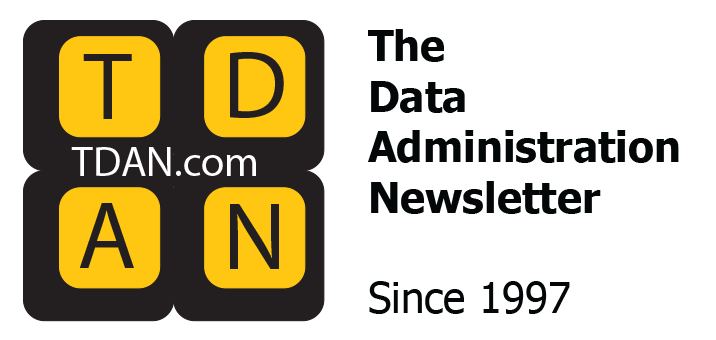
I recently published on this site a document I call the “Manifesto for Data Value Delivery” (aka, the “Data Value Manifesto”). Many thanks to those of you who have already reached out to me with suggestions and comments on this draft (if you want to, you can connect with me via LinkedIn; there’s a link to the draft Manifesto on my LinkedIn home page and you can either comment there or DM me).
I’m still working on ways to make the Manifesto more concise and easier to read and understand, especially the “Underlying Principles” section, which is getting a bit long and wordy. What I’d like to do in this article is lay out some of what I feel are important guiding principles for data management professionals, organized according to the four categories I introduced in my book “Data Model Storytelling: People, Business, Technology, and Data.”ii
People
- Empower people to create value for themselves, at the lowest possible level of the organization.
- Learn to effectively communicate with people on their level, and in their own language.
- Understand and effectively use the core principles of Agile and Human-Centered Design (HCD) to bring people together, brainstorm solutions, develop prototypes, and deliver results quickly, iteratively, and continually.
- Respect the legitimate interests of all stakeholders, working with the maximum amount of transparency and stakeholder involvement.
- Strive to become “Right Here” people, working with business people on the front lines of value delivery, rather than “Over There” people doing invisible technical work in a back office.
- Build a reputation as a “go to” and “can do” person the business can trust and rely on to get things done and deliver value. Make this your personal Brand.
- Concentrate on solving other people’s problems, not your own. Work to ensure the success of others.
- Maintain good working relationships with others at all times. Accept defeats and failures during projects as “Lessons Learned.”
Business
- Establish good working relationships with business people; get to know their problems and their needs.
- Develop a working knowledge of how businesses create and measure value; acquire business skills and acumen as well as technology skills.
- Prioritize attention on work that provides the greatest value to the organization, on business initiatives rather than data or BI initiatives. Better data is not a business outcome.
- Focus on supporting areas of the business, rather than applications or projects.
- Volunteer to work on data-related business initiatives (e.g., Digital Strategy).
- Make sure the right work is done at the right time, by the right people, in the right way, and for the right reasons.
- Stay business-focused and value-committed. Deliver business value as early and as continuously as possible.
Technology
- Commit to continuous learning; stay abreast of new technologies and new ways of doing things and integrate them into your work.
- Understand the Why of new technologies and methods, as much as the What and the How. What value are they intended to provide?
- Use the right tools in the right way for the right reasons.
- Have a solid, but extensible underlying architecture, to ensure fitness of purpose, reduce waste and reuse, encourage reuse and mitigate risk.
- Strive for simplicity, defined as “maximizing the amount of work not done.”
- Establish standards and support requirements up-front; don’t blindside teams in the middle of a project.
- Keep the PRISM Principles in mind: Performance, Reusability, Integrity, Security, and Maintainability.
- Refactor at the highest possible level of abstraction.
- Where possible, automate, streamline, or eliminate as many processes as possible.
Data
- Focus on data in motion (i.e., as streams of knowledge-creating information communicated to stakeholders), rather than data at rest (i.e., carefully curated data repositories that may or may not add value to organizations).
- Data is important and valuable only to the extent that it empowers organizations to achieve their goals. Strive to maximize the business value of data.
- Reusability contributes more to data value than quality. Data quality is important, but data doesn’t have to be perfect to be useful.
- Map data quality needs to customer requirements.
- Support enterprise data in all its forms (structured, unstructured, streaming, text, video, etc.).
- Develop measurable and business-relevant goals (i.e., OKRs) for data work, measure progress toward those goals, and then communicate that progress to management, so they can see the value that’s being produced.
- Distinguish between the logical and physical views of data (the Logical-Physical Divide). Understand what needs to be done where.
- Model what you know; implement what you need.
- Make the database (or data platform) do the data work. Avoid doing lots of data processing in the application or services layer or sending large volumes of data over the network.
- Abstract (i.e., virtualize) the consumption of data to maximize reuse.
- Communicate and evangelize the business value of good data management practices within your organization.
As I said in my earlier article,iii my goal is not to have a single version of the Data Value Manifesto that everybody genuflects to (like the Agile Manifesto). What I’d like to see is data teams adopting some version of this Manifesto (adapted to their own particular requirements and company culture) and then publishing it within their organization. Make it clear to your company’s business and IT stakeholders that you are committing yourselves to these core values and practices. Then, make sure to deliver on that commitment, to establish credibility as a trusted and knowledgeable business partner committed to furthering the goals and vision of your organization!
Publishing your data team’s version of the Manifesto within your organization not only signifies your commitment to delivering business value, but is an effective way of evangelizing the value of sound data management practices within your organization!
I’d welcome any and all suggestions and comments on this Manifesto, and any and all help developing these ideas. Anyone who wants to comment or help should connect with me on LinkedIn. I will post a link to this article on my LinkedIn page; feel free to add your input in the comments section.
i Burns, Larry. Data Model Storytelling: An Agile Approach to Maximizing the Value of Data Management (Technics Publications LLC, 2021), pp. 159-161. Note: Most of the suggested Data Value Delivery principles in this paper are taken from my books Building the Agile Database (Technics Publications, 2011), Growing Business Intelligence (Technics Publications, 2016), and Data Model Storytelling (Technics Publications, 2021).
ii Burns, Larry. Data Model Storytelling: An Agile Approach to Maximizing the Value of Data Management (Technics Publications LLC, 2021), pp. 159-161. Note: Most of the suggested Data Value Delivery principles in this paper are taken from my books Building the Agile Database (Technics Publications, 2011), Growing Business Intelligence (Technics Publications, 2016), and Data Model Storytelling (Technics Publications, 2021).
iii Burns, Larry. “A Data Value Manifesto”, op. cit.
